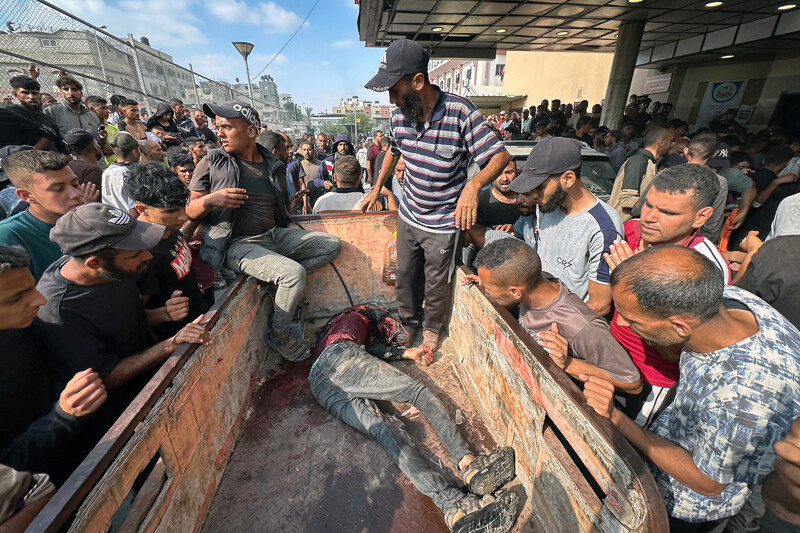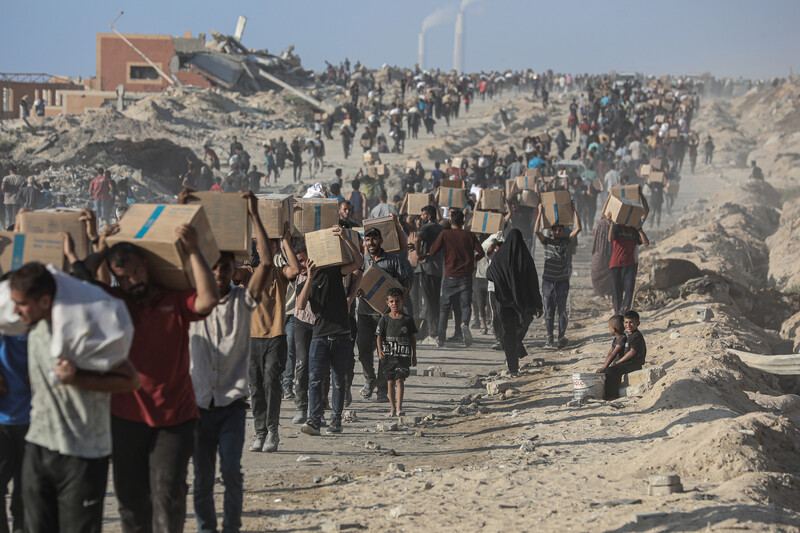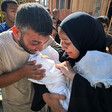Rights and Accountability 19 June 2025

Casualties are brought to Nasser Medical Complex after the Israeli military attacked people waiting to receive food aid in Khan Younis, southern Gaza, on 17 June.
APA imagesAt least 140 people were killed in Israeli attacks in Gaza over the past 24 hours as the confrontation between Israel and Iran teetered on the precipice of an even more dangerous conflagration.
Among those killed were people attempting to access aid being brought in by UN trucks in central Gaza.
Around 400 people have been killed while attempting to reach aid since the so-called Gaza Humanitarian Foundation began distributing food on 27 May, and more than 3,000 injured, according to authorities in Gaza.
More than 55,600 people have been killed in Gaza and nearly 130,000 injured since Israel’s military assault began in October 2023, according to the Palestinian health ministry in the territory. More than 5,330 people have been killed and nearly 18,000 injured since Israel broke a two-month-old ceasefire on 18 March.
The UN human rights office called on the Israeli military “to immediately cease its use of lethal force around food distribution points in Gaza, following repeated instances of shooting and killing of Palestinians seeking to access food there.”
People with serious injuries are without access to medical treatment due to Israel’s “almost complete destruction of the health system across Gaza,” the UN human rights office added.
“They face excruciating pain and potential death,” the office added.
Civil order in Gaza has severely deteriorated due to Israel’s attacks, total blockade and targeting of the civilian police force.
“As a result, Palestinians are increasingly facing the inhumane choice of dying from starvation or risking being killed while trying to access the little food that is available,” the UN human rights office said.
Dozens killed waiting for aid
At least 70 people were killed and 200 injured when the Israeli military fired tank shells at a crowd of Palestinians waiting for UN food trucks in Khan Younis, southern Gaza, on 17 June. It was the deadliest incident at an aid site after such mass casualty events near distribution points became an almost daily occurrence when an American-Israeli militarized aid scheme began operating in Gaza in late May.
Medics at Nasser Medical Complex in Khan Younis “had to clear the maternity ward to make space for the wounded, turning delivery rooms into emergency operating theatres,” according to Doctors Without Borders.
“Many of the injuries required amputations to save the patients’ lives,” the charity added.
Euro-Med Monitor, a human rights group based in Geneva, said that its field team in Gaza had documented the involvement of a local armed gang collaborating with the Israeli military in deadly attacks on people attempting to reach aid points.
The group said it also “received credible information that a foreign mercenary employed by the US security company overseeing the aid distribution center shot and killed a civilian” near Rafah, in southern Gaza, on 9 June.
Israel is also facilitating the looting of humanitarian aid, fueling hunger and chaos in Gaza, the Palestinian human rights group Al Mezan said in a report published on 14 June.
The escalation of looting throughout May and early June points to “a systematic Israeli policy that weaponizes starvation, deprivation and chaos to further its genocidal campaign,” according to Al Mezan.
Aid is vulnerable to looting by armed groups “due to the absence of protected corridors and effective distribution oversight,” the rights group added.
“Convoys are frequently ambushed, supplies seized, and warehouses belonging to UN agencies, including UNRWA and the World Food Program, stormed either by armed groups or desperate civilians.”
The Israeli military “dictates the routes that aid trucks must follow,” forcing drivers to go through “overcrowded and high-risk areas heavily populated by displaced families,” increasing the likelihood of looting.
Looted supplies are being sold in Gaza’s markets at unaffordable prices, turning humanitarian aid “into a tool of economic exploitation and coercion,” Al Mezan said.
The severe shortage of food and essential medicines in Gaza has had “a devastating impact on pregnant women, breastfeeding mothers and children in general,” a doctor at Al-Awda Hospital in central Gaza told the UNFPA, the United Nations sexual and reproductive health agency.
“We are witnessing a significant increase in cases of low birth weight babies, directly linked to maternal malnutrition and anemia during pregnancy,” the doctor added.
Aid trickles into starving north
Humanitarian aid trickled into northern Gaza on Monday, when thousands of people converged on a distribution point in Gaza City to receive food ration boxes from the UN World Food Program, The New York Times reported.
The extremely limited amount of aid that Israel is currently allowing into Gaza represents a fraction of what entered during a short-lived ceasefire that began in late January.
Half a million Palestinians – an estimated one in five people in Gaza – are facing starvation, according to an international famine monitoring group.

People carry UN food ration boxes in Gaza City on 16 June.
APA imagesUNFPA said that nearly 11,000 pregnant women in Gaza are reported to be at risk of famine and “nearly 17,000 pregnant and breastfeeding women will need urgent treatment for acute malnutrition over the coming months.”
An estimated “one in three pregnancies are now considered high-risk, and one in five newborns are born preterm or underweight, requiring specialist care that is increasingly unavailable,” the agency added.
More than 190 trucks loaded with urgently needed supplies – including mobile maternity units, ultrasounds and portable incubators for premature infants – have been denied entry into Gaza, according to UNFPA.
Meanwhile, Israel is preventing international and UN organizations from accessing fuel storage sites in Gaza, claiming they are in combat zones, leaving hospitals with enough fuel to power generators for only three more days, according to the Palestinian health ministry in the territory.
Nasser hospital on brink of collapse
Dr. Yousef Abu al-Rish, the deputy health minister in Gaza, warned on Tuesday that Nasser Medical Complex – the largest hospital in southern Gaza – was on the brink of collapse following another massacre of Palestinians attempting to secure aid that morning.
The hospital lacked supplies and had run out of consumables and other items necessary for the provision of emergency medical treatment while staff were working on empty stomachs due to a lack of food and cooking gas.
Because of widespread malnutrition, people are no longer able to donate blood in Gaza, he said.
There will be no place for patients to receive specialized care if Nasser hospital is forced to shut down due to Israeli attacks and evacuation orders, the International Committee of the Red Cross warned on 14 June.
In addition to specialized care, Nasser Medical Complex “provides blood bank services” that allow for blood transfusions at the Red Cross Field Hospital in Rafah and “forensic services and management of the dead,” the Red Cross said.The humanitarian organization added that its field hospital in Rafah has received a “massive influx of weapon-wounded patients” injured at aid distribution sites.
On 12 June, the Red Cross said that the number of patients received in the previous two weeks “is higher than all mass casualty incidents over the 12 months prior combined.”
A majority of patients reported that they were attempting to reach aid points when they incurred gunshot and shrapnel wounds.
Israeli military orders forcing people from their homes and shelters are steadily encroaching on the Khan Younis area.
Satellite imagery analyzed by Amnesty International reveals the deliberate and complete razing of what remained in Khuzaa, a town with a former population of 11,000 people near Khan Younis, during the last two weeks of May.
An Israeli military commander Dor Yoetz stated on 25 May that troops had set out to “eliminate the terrorist nest” of Khuzaa, which “no longer exists.”
Erika Guevara Rosas, a director of research at Amnesty International, which analyzed satellite imagery documenting the destruction of Khuzaa, called for “an independent and impartial investigation” into the erasure of the town.
Rosas added that the “blatant act of wanton destruction” demonstrates Israel’s “calculated plan to transform Gaza into a wasteland, destroy its social fabric and continue inflicting on Palestinians conditions that would lead to their physical destruction.”
“This is genocide and it must end now,” Rosas said.






Add new comment